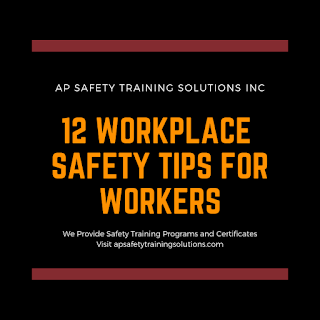12 Workplace Safety Training Tips for Workers
What Is Workplace Safety Training?
Workplace safety training intends to ensure your employees aren't injured at work. Its goal is to develop a health and safety program where safety becomes second nature. It also makes it possible to meet with your legal obligation to protect individuals and employees.Employees remain committed and loyal based on your abilities to supply them with safety knowledge.
12 Workplace Safety Training Tips for Workers:
1. Safety training has to be bolstered if employees fail to comprehend and implement their knowledge.
This requires you to track their progress after safety training to quantify how well your employees are employing the best safety practices that apply to their own particular job.
2. Materials should be presented in the sequence of the steps.
Safety training should be quite methodical. All security knowledge moved to workers ought to be presented in order, as it is more easy for them to put it into practice.
3. Safety changes upon illnesses, accidents, incidents, and injuries.
Safety training is not just about attending classes. The largest learning experiences occur at the moment. Apply security changes, Whenever there's a workplace accident.
4. Affected workers must be updated with the newest changes to processes and policies.
It is best to hold routine meetings that address updated policies and procedures so that your workers are not left in the dark. A consistent message keeps them aware of important workplace security is.
5. Workers exposed to risk has to be upgraded with new security training.
Especially for those workers whose jobs are at a higher risk for accidents, they ought to be refreshed and retrained on a normal basis.
6. Executives and security officers must keep communication open to allow workers to become more comfortable with giving and learning their opinions.
Employee feedback is important in understanding their hands-on experience with certain security procedures. It also keeps them engaged.
7. Lecturing proves to be not as powerful than hands-on instruction and demonstration.
Safety training requires"performing" to truly have an impact. Lecturing is passive and, well... boring. You want your workers engaged.
8. It's important to give feedback on how the safety training is adapted to by your workers so that they know what they are doing correctly.
Supervisors should watch workers do their jobs and question them to recognize what they do or do not know about best safety practices for their job.
9. When coaching workers produce a lasting impression relating events.
It requires under a second to lose the remainder of your life. And these real-life stories happen. It's hard to ignore how important it is to apply what they've learned in safety training daily upon hearing them.
10. Always be certain that you train workers specific to their field of work.
Each job, every device, every bit of equipment differs and requires a particular set of safety knowledge and expertise to utilize them properly.
11. So employees aren't currently cramming to memorize the information, spread out your coaching days.
Only so much information is retained in a safety training session. Break up training within a few days to keep your workers' minds fresh and engaged for an optimal learning experience.
12. Keep workers attentive by discussions in coaching sessions.
Q&A's are a great way to keep employees engaged and active within their security instruction. Additionally, it encourages them to think about the tips' utilization in their daily work.
Successful training ends ineffective safety measures they use on the job. Safety training helps your company prevent workplace injuries to preserve the well-being and health of your employees while avoiding the costs of these accidents.
Need a Workplace Safety Training Course
Contact AP Safety Training Solutions today at (888) 501-1355 for questions regarding quotes and programs available to you. Classes fill quickly.




safety course in Chennai
ReplyDelete